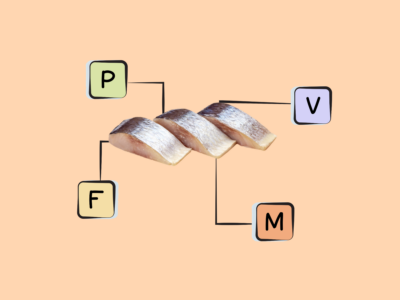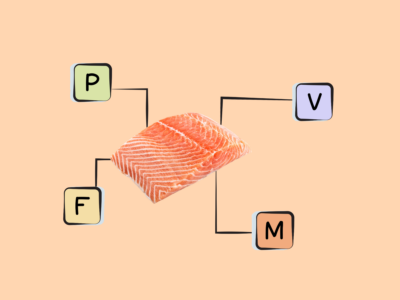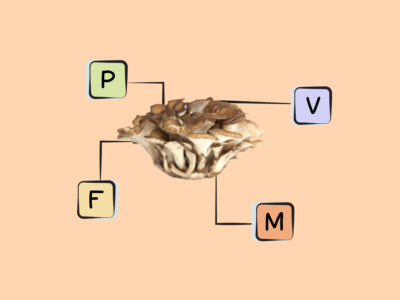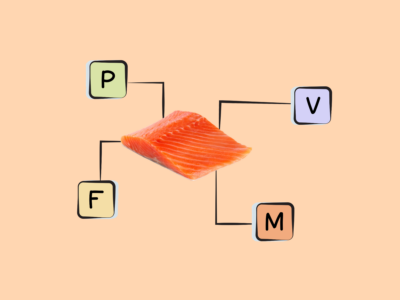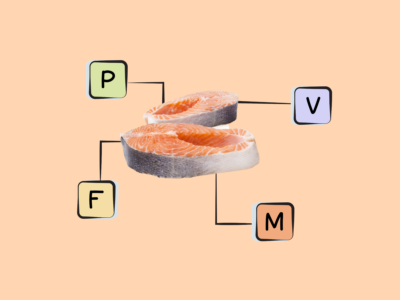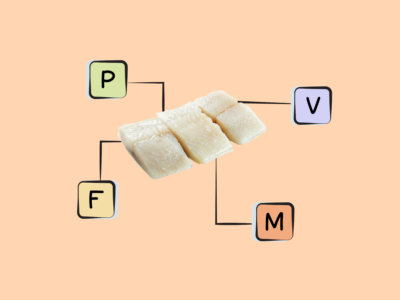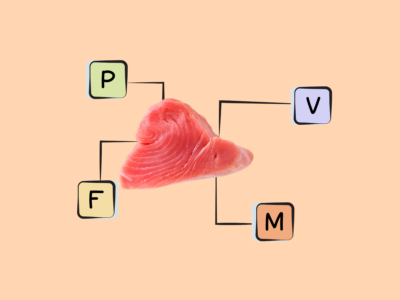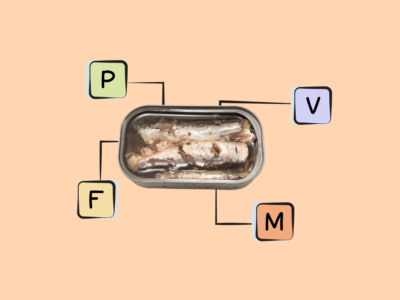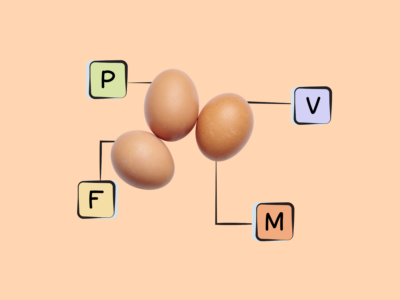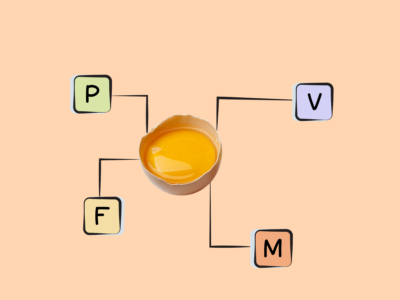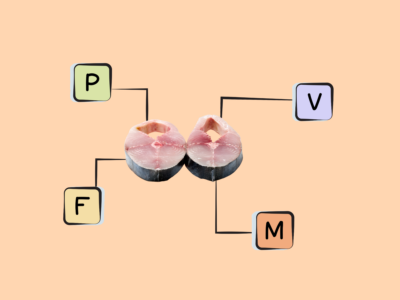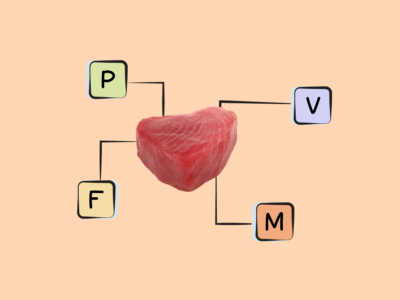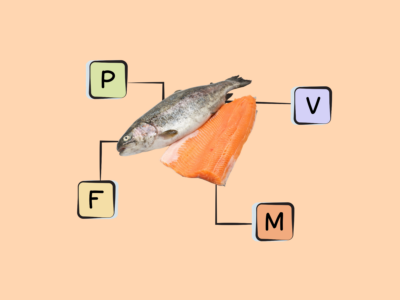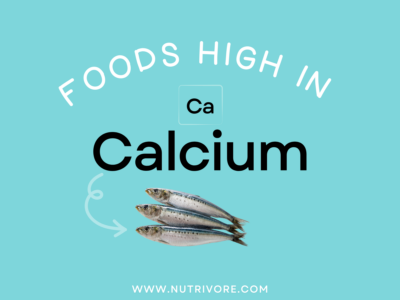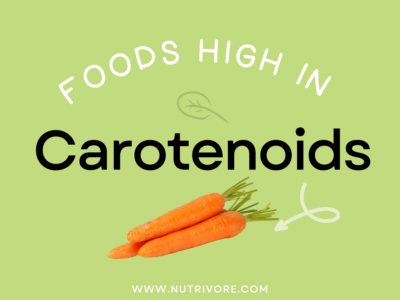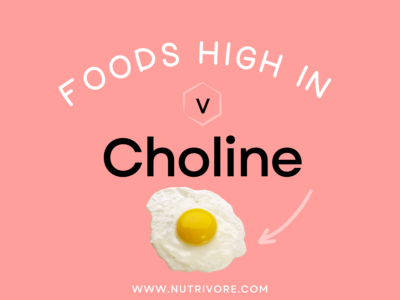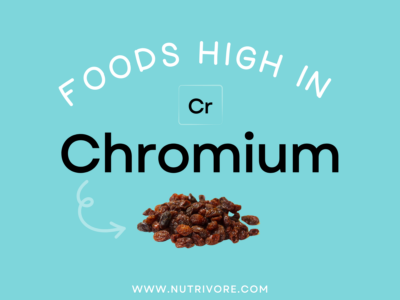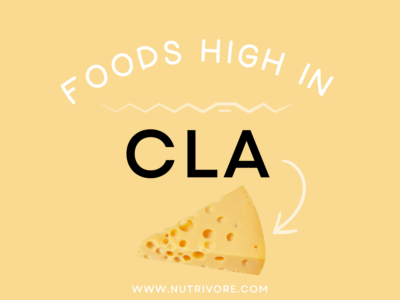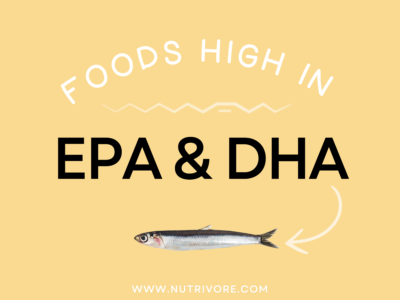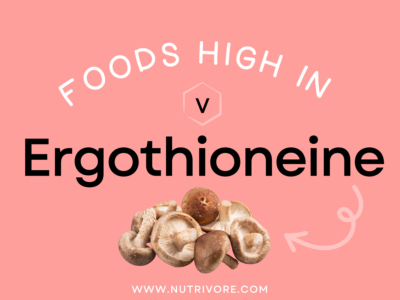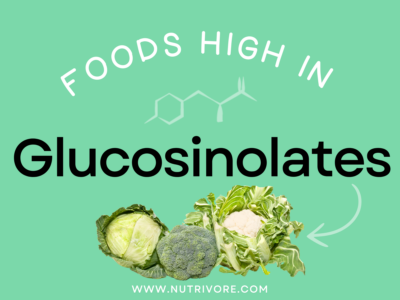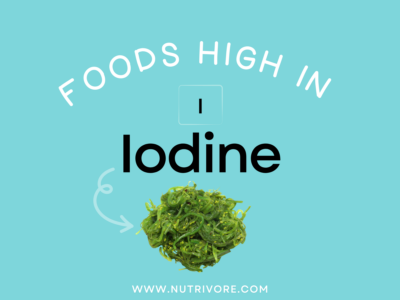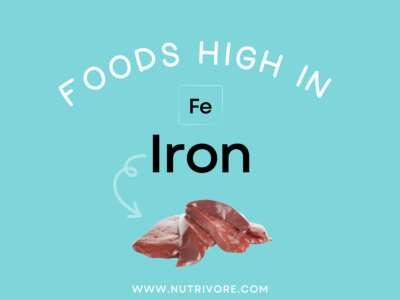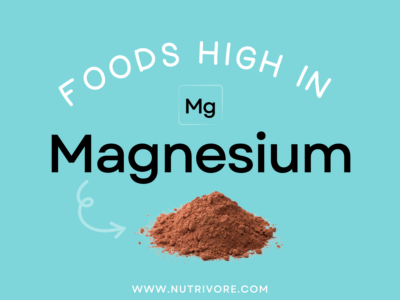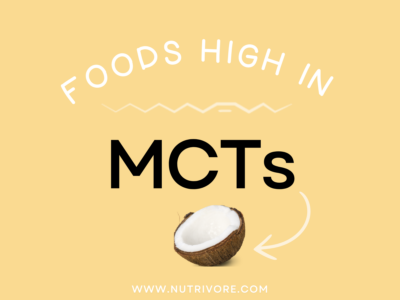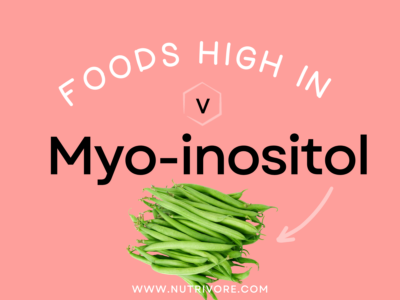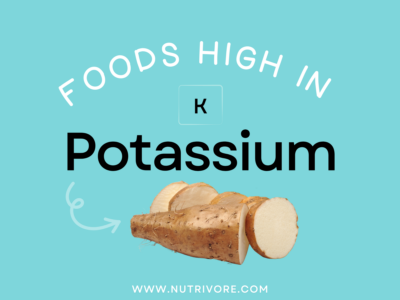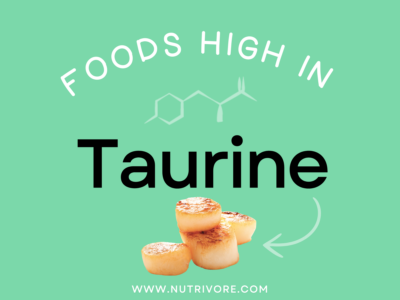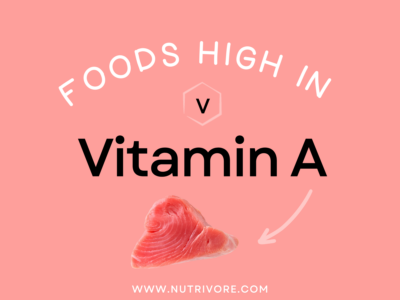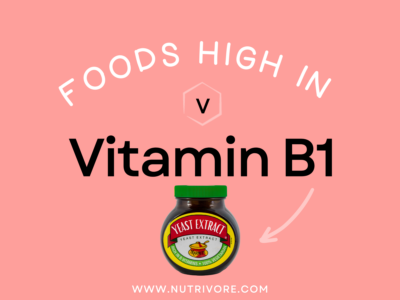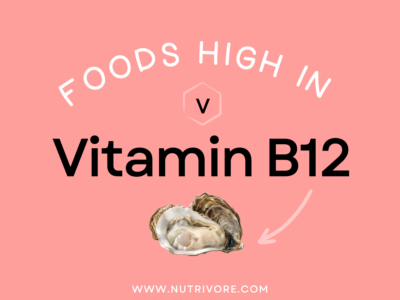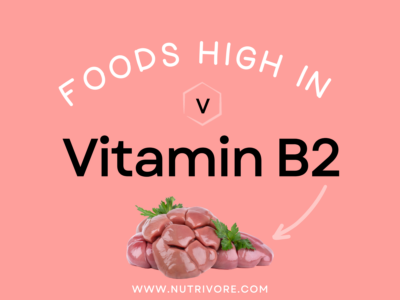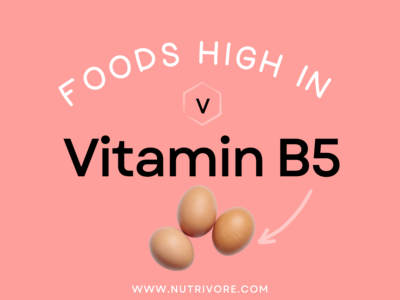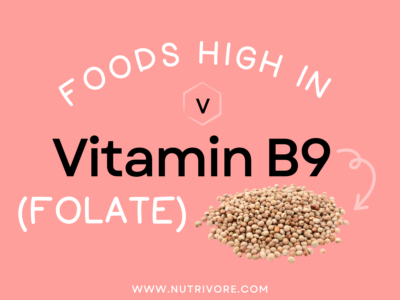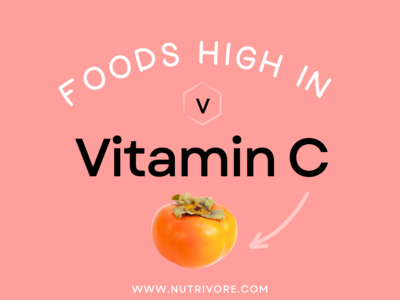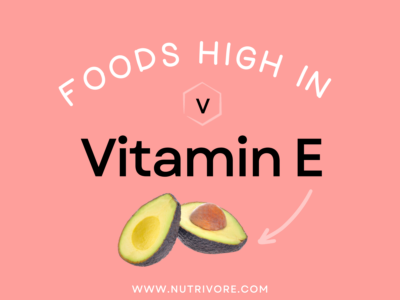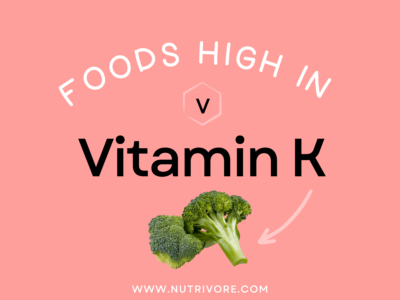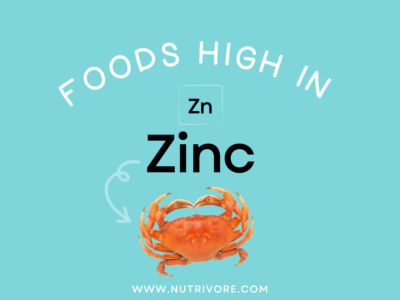Table of Contents[Hide][Show]
Top 5 Common Food Sources of Vitamin D
Looking to get more mcg of vitamin D in your diet? Look no further! My team and I have crunched the numbers and did all the math to determine the top 5 common food sources of vitamin D, per serving.
| Rank | Food | Nutrivore Score | Serving Size (Raw) | Vitamin D (µg/serving) | % Daily Value |
|---|---|---|---|---|---|
| 1 | Eel, Mixed Species | 385 | 4 oz / 115 g | 26.8 | 134 |
| 2 | Maitake Mushrooms | 3551 | 1 cup, diced | 21.6 | 108 |
| 3 | Atlantic Mackerel | 922 | 4 oz / 115 g | 18.5 | 93 |
| 4 | Swordfish | 557 | 4 oz / 115 g | 16.0 | 80 |
| 5 | Salmon, Average1 | 712 | 4 oz / 115 g | 14.2 | 71 |
Want to know more about this important vitamin including what vitamin D does in the body, how much vitamin D we need, what happens if we have low levels of vitamin D levels or if we get too much, and even more awesome food sources of vitamin D? Keep reading to learn all there is to know!
Learn What Foods Are the Best Sources of Every Nutrient

The Top 25 Foods for Every Nutrient
The Top 25 Foods for Every Nutrient e-book is a well-organized, easy-to-use, grocery store-friendly guide to help you choose foods that fit your needs of 43 important nutrients while creating a balanced nutrient-dense diet.
Get two “Top 25” food lists for each nutrient, plus you’ll find RDA charts for everyone, informative visuals, fun facts, serving sizes and the 58 foods that are Nutrient Super Stars!
Buy now for instant digital access.
What Is Vitamin D and What Does It Do?
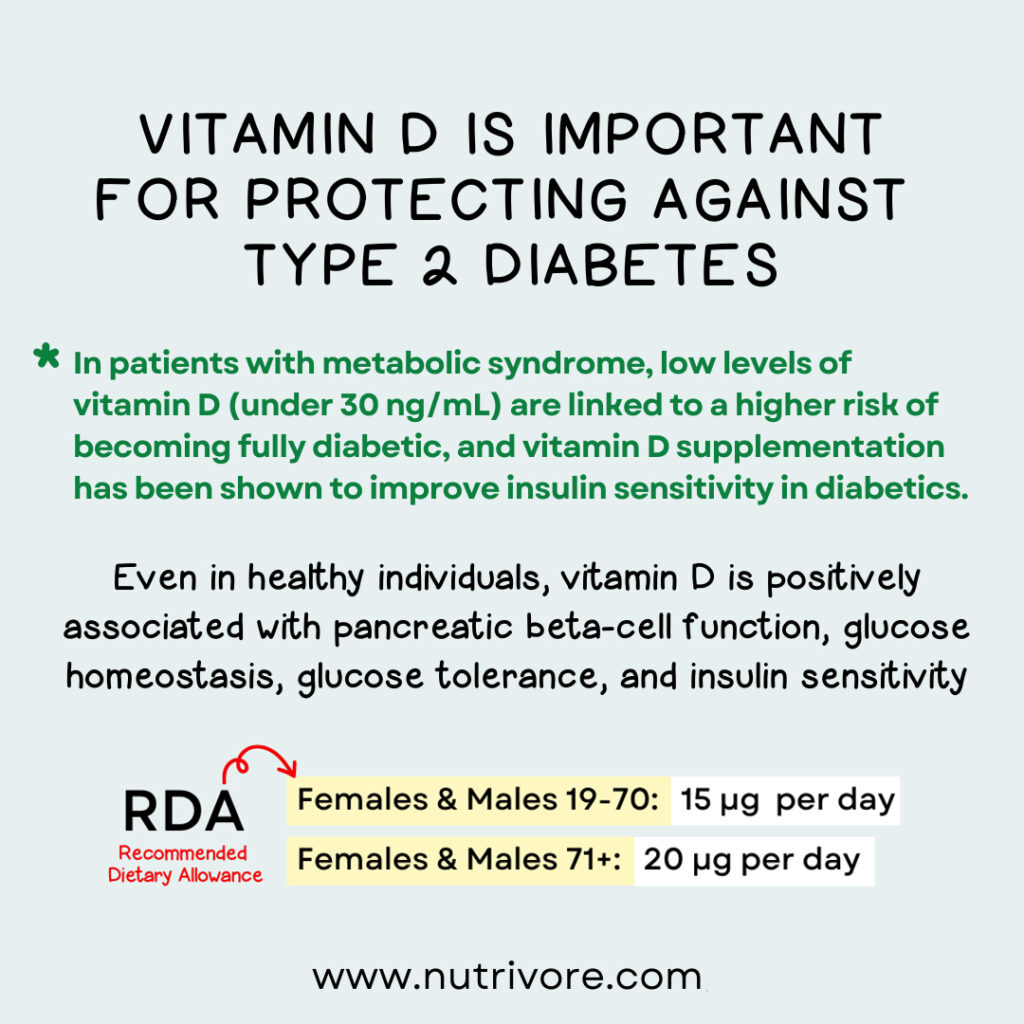
Vitamin D is actually a group of fat-soluble steroid hormones, distinct from “true” vitamins because we can obtain it from non-dietary sources! In fact, sun exposure is a major way we get vitamin D, produced by the interaction between ultraviolet (UV) radiation and a special sterol in our skin. In humans, the most important forms are vitamin D3 (also called cholecalciferol) and vitamin D2 (also called ergocalciferol).
Nearly every cell in the body expresses the vitamin D receptor, giving vitamin D control of over 200 genes (and the proteins they regulate)! As a result, vitamin D is heavily involved in numerous biological processes, including the immune system, cell differentiation, gut barrier function, nutrient absorption (particularly of calcium, magnesium, and phosphorus), bone formation, cardiometabolic health, and neurological health.
Research has shown that vitamin D can reduce the risk of autoimmune disease, plays a protective role against some cancers (especially breast and colorectal), may reduce the risk of type 2 diabetes, protects against inflammatory bowel diseases, and may even benefit Alzheimer’s disease and Parkinson’s disease. Without enough vitamin D, risk of pregnancy complications, bone fractures, and total mortality all go up!
Learn more about vitamin D here.
Vitamin D Deficiency
A 2011 study evaluated American’s usual nutrient intake including nutrients that are naturally-occurring in foods, from fortified and enriched foods, and from supplements. The results indicated that an astounding 100% of American adults usual diet falls short of the Estimated Average Requirement (EAR) for vitamin D intake.
Groups At Risk
A number of risk factors can increase the likelihood of low vitamin D levels, including:
- environmental conditions (living in cloudy climates or at high latitudes),
- reduced skin exposure to the sun (such as from always wearing sunscreen or being covered by clothing),
- skin pigmentation (people with dark skin produce less vitamin D from sun exposure),
- genetic variations,
- inflammatory bowel diseases or fat malabsorption syndromes,
- having cystic fibrosis (which impairs the absorption and metabolism of fat-soluble vitamins),
- older adults (lower capacity to synthesize vitamin D),
- obesity,
- magnesium deficiency, and/or
- having liver or kidney disease.
Learn more here.
Symptoms of Deficiency
In children, severe vitamin D deficiency can cause rickets, leading to improperly mineralized bones, bone deformities, and, in severe cases, seizures. In adults, deficiency results in osteomalacia, causing bone softening, pain, and increased osteoporosis risk. Other symptoms include muscle weakness, fatigue, mood changes, and secondary hyperparathyroidism, which accelerates bone loss ultimately leading to osteoporosis. Long-term vitamin D deficiency may also contribute to various chronic diseases.
Learn more here.
Problems From Too Much Vitamin D
While vitamin D toxicity is rare and doesn’t occur from sun exposure, extremely high doses from supplements (especially above 50,000 international units or IU daily) can cause hypercalcemia, leading to kidney stones, bone loss, and calcification in the heart or kidneys. Symptoms may include fatigue, constipation, muscle weakness, and dehydration. Those with certain conditions, like sarcoidosis or hyperparathyroidism, are at higher risk. Consulting a healthcare professional for medical advice is recommended before using high-dose vitamin D supplements.
Learn more here.
How Much Vitamin D Do We Need?
The following table summarizes the current recommended levels of vitamin D, based on age, gender, or situation. (For reference 1 microgram of vitamin D is equal to 40 IU of vitamin D.)
Vitamin D requirements are difficult to standardize, as it can be obtained from food and synthesized by the body. For those with deficiency or insufficiency, many professionals recommend individualized supplementation based on regular testing of 25-hydroxyvitamin D levels every 3-6 months. Higher intakes may be necessary for breastfeeding individuals in order to produce milk with high enough vitamin D content to meet infants’ needs, with options including daily supplements or a monthly dose. Vitamin D can be stored in the liver, allowing intake fluctuations without immediate deficiency. Maintaining optimal blood levels (50-70 ng/mL) is key, regardless of whether it’s achieved through diet, supplements, or sun exposure.
It’s also important to note that vitamin D has some important interactions with other nutrients, namely it regulates the absorption of calcium, phosphorus, and magnesium. The role of vitamin D in regulating calcium and phosphorus means that vitamin D helps with bone health. Learn more here.
| 0 – 6 months | |||||
| 6 months to < 12 months | |||||
| 1 yr – 3 yrs | |||||
| 4 yrs – 8 yrs | |||||
| 9 yrs – 13 yrs | |||||
| 14 yrs – 18 yrs | |||||
| 19 yrs – 50 yrs | |||||
| 51+ yrs | |||||
| Pregnant (14 – 18 yrs) | |||||
| Pregnant (19 – 30 yrs) | |||||
| Pregnant (31 – 50 yrs) | |||||
| Lactating (14 – 18 yrs) | |||||
| Lactating (19 – 30 yrs) | |||||
| Lactating (31 – 50 yrs) |
Nutrient Daily Values
Nutrition requirements and recommended nutrient intake for infants, children, adolescents, adults, mature adults, and pregnant and lactating individuals.
More Food Sources of Vitamin D
Other food sources of vitamin D include fatty fish (like salmon, mackerel, sardines, and herring), fish eggs (roe), beef liver, red meat, and egg yolks. Mushrooms grown under UV light are the only substantial non-animal-food source of naturally occurring vitamin D (mostly in the form of vitamin D2); grown under the same conditions, baker’s yeast can also produce vitamin D2. And, in some countries (including the US), a number of foods that don’t naturally contain vitamin D are fortified with it, such as store-bought orange juice, breakfast cereals, some dairy products such as cow’s milk, and plant-based milks such as almond milk and soy milk.
Best Food Sources of Vitamin D
The following foods have high concentrations of vitamin D, containing at least 50% of the recommended dietary allowance per serving, making them our best vitamin D foods.
Good Food Sources of Vitamin D
The following foods are also excellent or good sources of vitamin D, containing at least 10% (and up to 50%) of the daily value per serving.
Top 5 Common Food Sources
If you’re looking for top 5 common food sources of other important nutrients check out these posts!
cITATIONS
Expand to see all scientific references for this article.
Ahn J, Yu K, Stolzenberg-Solomon R, Simon KC, McCullough ML, Gallicchio L, Jacobs EJ, Ascherio A, Helzlsouer K, Jacobs KB, Li Q, Weinstein SJ, Purdue M, Virtamo J, Horst R, Wheeler W, Chanock S, Hunter DJ, Hayes RB, Kraft P, Albanes D. Genome-wide association study of circulating vitamin D levels. Hum Mol Genet. 2010 Jul 1;19(13):2739-45. doi: 10.1093/hmg/ddq155.
Al Mheid I, Patel R, Murrow J, Morris A, Rahman A, Fike L, Kavtaradze N, Uphoff I, Hooper C, Tangpricha V, Alexander RW, Brigham K, Quyyumi AA. Vitamin D status is associated with arterial stiffness and vascular dysfunction in healthy humans. J Am Coll Cardiol. 2011 Jul 5;58(2):186-92. doi: 10.1016/j.jacc.2011.02.051.
Al-Khalidi B, Kimball SM, Rotondi MA, Ardern CI. Standardized serum 25-hydroxyvitamin D concentrations are inversely associated with cardiometabolic disease in U.S. adults: a cross-sectional analysis of NHANES, 2001-2010. Nutr J. 2017 Feb 28;16(1):16. doi: 10.1186/s12937-017-0237-6.
Ananthakrishnan AN, Khalili H, Higuchi LM, Bao Y, Korzenik JR, Giovannucci EL, Richter JM, Fuchs CS, Chan AT. Higher predicted vitamin D status is associated with reduced risk of Crohn’s disease. Gastroenterology. 2012 Mar;142(3):482-9. doi: 10.1053/j.gastro.2011.11.040.
Annweiler C, Fantino B, Schott AM, Krolak-Salmon P, Allali G, Beauchet O. Vitamin D insufficiency and mild cognitive impairment: cross-sectional association. Eur J Neurol. 2012 Jul;19(7):1023-9. doi: 10.1111/j.1468-1331.2012.03675.x.
Annweiler C, Milea D, Whitson HE, Cheng CY, Wong TY, Ikram MK, Lamoureux EL, Sabanayagam C. Vitamin D insufficiency and cognitive impairment in Asians: a multi-ethnic population-based study and meta-analysis. J Intern Med. 2016 Sep;280(3):300-11. doi: 10.1111/joim.12491.
Annweiler C, Rolland Y, Schott AM, Blain H, Vellas B, Herrmann FR, Beauchet O. Higher vitamin D dietary intake is associated with lower risk of alzheimer’s disease: a 7-year follow-up. J Gerontol A Biol Sci Med Sci. 2012 Nov;67(11):1205-11. doi: 10.1093/gerona/gls107.
Antico A, Tampoia M, Tozzoli R, Bizzaro N. Can supplementation with vitamin D reduce the risk or modify the course of autoimmune diseases? A systematic review of the literature. Autoimmun Rev. 2012 Dec;12(2):127-36. doi: 10.1016/j.autrev.2012.07.007.
Aranow C. Vitamin D and the immune system. J Investig Med. 2011 Aug;59(6):881-6. doi: 10.2310/JIM.0b013e31821b8755.
Balion C, Griffith LE, Strifler L, Henderson M, Patterson C, Heckman G, Llewellyn DJ, Raina P. Vitamin D, cognition, and dementia: a systematic review and meta-analysis. Neurology. 2012 Sep 25;79(13):1397-405. doi: 10.1212/WNL.0b013e31826c197f.
Bashir M, Prietl B, Tauschmann M, Mautner SI, Kump PK, Treiber G, Wurm P, Gorkiewicz G, Högenauer C, Pieber TR. Effects of high doses of vitamin D3 on mucosa-associated gut microbiome vary between regions of the human gastrointestinal tract. Eur J Nutr. 2016 Jun;55(4):1479-89. doi: 10.1007/s00394-015-0966-2.
Bassil D, Rahme M, Hoteit M, Fuleihan Gel-H. Hypovitaminosis D in the Middle East and North Africa: Prevalence, risk factors and impact on outcomes. Dermatoendocrinol. 2013 Apr 1;5(2):274-98. doi: 10.4161/derm.25111.
Bikle DD. Vitamin D metabolism, mechanism of action, and clinical applications. Chem Biol. 2014 Mar 20;21(3):319-29. doi: 10.1016/j.chembiol.2013.12.016.
Bikle DD. Vitamin D: an ancient hormone. Exp Dermatol. 2011 Jan;20(1):7-13. doi: 10.1111/j.1600-0625.2010.01202.x. PMID: 21197695.
Bjelakovic G, Gluud LL, Nikolova D, Whitfield K, Wetterslev J, Simonetti RG, Bjelakovic M, Gluud C. Vitamin D supplementation for prevention of mortality in adults. Cochrane Database Syst Rev. 2014 Jan 10;(1):CD007470. doi: 10.1002/14651858.CD007470.pub3.
Cardwell G, Bornman JF, James AP, Black LJ. A Review of Mushrooms as a Potential Source of Dietary Vitamin D. Nutrients. 2018 Oct 13;10(10):1498. doi: 10.3390/nu10101498.
Chapuy MC, Preziosi P, Maamer M, Arnaud S, Galan P, Hercberg S, Meunier PJ. Prevalence of vitamin D insufficiency in an adult normal population. Osteoporos Int. 1997;7(5):439-43. doi: 10.1007/s001980050030.
Chiu KC, Chu A, Go VL, Saad MF. Hypovitaminosis D is associated with insulin resistance and beta cell dysfunction. Am J Clin Nutr. 2004 May;79(5):820-5. doi: 10.1093/ajcn/79.5.820.
Choi YJ, Kim YH, Cho CH, Kim SH, Lee JE. Circulating levels of vitamin D and colorectal adenoma: A case-control study and a meta-analysis. World J Gastroenterol. 2015 Aug 7;21(29):8868-77. doi: 10.3748/wjg.v21.i29.8868.
Chowdhury R, Kunutsor S, Vitezova A, Oliver-Williams C, Chowdhury S, Kiefte-de-Jong JC, Khan H, Baena CP, Prabhakaran D, Hoshen MB, Feldman BS, Pan A, Johnson L, Crowe F, Hu FB, Franco OH. Vitamin D and risk of cause specific death: systematic review and meta-analysis of observational cohort and randomised intervention studies. BMJ. 2014 Apr 1;348:g1903. doi: 10.1136/bmj.g1903.
Chung M, Lee J, Terasawa T, Lau J, Trikalinos TA. Vitamin D with or without calcium supplementation for prevention of cancer and fractures: an updated meta-analysis for the U.S. Preventive Services Task Force. Ann Intern Med. 2011 Dec 20;155(12):827-38. doi: 10.7326/0003-4819-155-12-201112200-00005. Erratum in: Ann Intern Med. 2014 Oct 21;161(8):615-6.
Deng X, Song Y, Manson JE, Signorello LB, Zhang SM, Shrubsole MJ, Ness RM, Seidner DL, Dai Q. Magnesium, vitamin D status and mortality: results from US National Health and Nutrition Examination Survey (NHANES) 2001 to 2006 and NHANES III. BMC Med. 2013 Aug 27;11:187. doi: 10.1186/1741-7015-11-187.
Ekmekcioglu C, Haluza D, Kundi M. 25-Hydroxyvitamin D Status and Risk for Colorectal Cancer and Type 2 Diabetes Mellitus: A Systematic Review and Meta-Analysis of Epidemiological Studies. Int J Environ Res Public Health. 2017 Jan 28;14(2):127. doi: 10.3390/ijerph14020127.
Fulgoni VL 3rd, Keast DR, Bailey RL, Dwyer J. Foods, fortificants, and supplements: Where do Americans get their nutrients? J Nutr. 2011 Oct;141(10):1847-54. doi: 10.3945/jn.111.142257. Epub 2011 Aug 24. PMID: 21865568; PMCID: PMC3174857.
Gallagher JC, Yalamanchili V, Smith LM. The effect of vitamin D supplementation on serum 25(OH)D in thin and obese women. J Steroid Biochem Mol Biol. 2013 Jul;136:195-200. doi: 10.1016/j.jsbmb.2012.12.003.
Gandini S, Boniol M, Haukka J, Byrnes G, Cox B, Sneyd MJ, Mullie P, Autier P. Meta-analysis of observational studies of serum 25-hydroxyvitamin D levels and colorectal, breast and prostate cancer and colorectal adenoma. Int J Cancer. 2011 Mar 15;128(6):1414-24. doi: 10.1002/ijc.25439.
Garland CF, Garland FC, Gorham ED. Calcium and vitamin D. Their potential roles in colon and breast cancer prevention. Ann N Y Acad Sci. 1999;889:107-19. doi: 10.1111/j.1749-6632.1999.tb08728.x.
Gröber U, Spitz J, Reichrath J, Kisters K, Holick MF. Vitamin D: Update 2013: From rickets prophylaxis to general preventive healthcare. Dermatoendocrinol. 2013 Jun 1;5(3):331-47. doi: 10.4161/derm.26738.
Holick MF, Binkley NC, Bischoff-Ferrari HA, Gordon CM, Hanley DA, Heaney RP, Murad MH, Weaver CM; Endocrine Society. Evaluation, treatment, and prevention of vitamin D deficiency: an Endocrine Society clinical practice guideline. J Clin Endocrinol Metab. 2011 Jul;96(7):1911-30. doi: 10.1210/jc.2011-0385. Epub 2011 Jun 6. Erratum in: J Clin Endocrinol Metab. 2011 Dec;96(12):3908.
Holick MF. Vitamin D: importance in the prevention of cancers, type 1 diabetes, heart disease, and osteoporosis. Am J Clin Nutr. 2004 Mar;79(3):362-71. doi: 10.1093/ajcn/79.3.362.
Hu K, Callen DF, Li J, Zheng H. Circulating Vitamin D and Overall Survival in Breast Cancer Patients: A Dose-Response Meta-Analysis of Cohort Studies. Integr Cancer Ther. 2018 Jun;17(2):217-225. doi: 10.1177/1534735417712007.
Hyppönen E, Läärä E, Reunanen A, Järvelin MR, Virtanen SM. Intake of vitamin D and risk of type 1 diabetes: a birth-cohort study. Lancet. 2001 Nov 3;358(9292):1500-3. doi: 10.1016/S0140-6736(01)06580-1.
Jahnsen J, Falch JA, Mowinckel P, Aadland E. Vitamin D status, parathyroid hormone and bone mineral density in patients with inflammatory bowel disease. Scand J Gastroenterol. 2002 Feb;37(2):192-9. doi: 10.1080/003655202753416876.
John EM, Schwartz GG, Dreon DM, Koo J. Vitamin D and breast cancer risk: the NHANES I Epidemiologic follow-up study, 1971-1975 to 1992. National Health and Nutrition Examination Survey. Cancer Epidemiol Biomarkers Prev. 1999 May;8(5):399-406.
Jones AN, Hansen KE. Recognizing the musculoskeletal manifestations of vitamin D deficiency. J Musculoskelet Med. 2009 Oct;26(10):389-396.
Khan H, Kunutsor S, Franco OH, Chowdhury R. Vitamin D, type 2 diabetes and other metabolic outcomes: a systematic review and meta-analysis of prospective studies. Proc Nutr Soc. 2013 Feb;72(1):89-97. doi: 10.1017/S0029665112002765.
Khosravi ZS, Kafeshani M, Tavasoli P, Zadeh AH, Entezari MH. Effect of Vitamin D Supplementation on Weight Loss, Glycemic Indices, and Lipid Profile in Obese and Overweight Women: A Clinical Trial Study. Int J Prev Med. 2018 Jul 20;9:63. doi: 10.4103/ijpvm.IJPVM_329_15.
Kim G, Bae JH. Vitamin D and atopic dermatitis: A systematic review and meta-analysis. Nutrition. 2016 Sep;32(9):913-20. doi: 10.1016/j.nut.2016.01.023.
Kim Y, Je Y. Vitamin D intake, blood 25(OH)D levels, and breast cancer risk or mortality: a meta-analysis. Br J Cancer. 2014 May 27;110(11):2772-84. doi: 10.1038/bjc.2014.175.
Kunutsor SK, Apekey TA, Steur M. Vitamin D and risk of future hypertension: meta-analysis of 283,537 participants. Eur J Epidemiol. 2013 Mar;28(3):205-21. doi: 10.1007/s10654-013-9790-2.
Lacroix M, Battista MC, Doyon M, Houde G, Ménard J, Ardilouze JL, Hivert MF, Perron P. Lower vitamin D levels at first trimester are associated with higher risk of developing gestational diabetes mellitus. Acta Diabetol. 2014 Aug;51(4):609-16. doi: 10.1007/s00592-014-0564-4.
Lee YH, Bae SC. Vitamin D level in rheumatoid arthritis and its correlation with the disease activity: a meta-analysis. Clin Exp Rheumatol. 2016 Sep-Oct;34(5):827-833.
Liao Y, Huang JL, Qiu MX, Ma ZW. Impact of serum vitamin D level on risk of bladder cancer: a systemic review and meta-analysis. Tumour Biol. 2015 Mar;36(3):1567-72. doi: 10.1007/s13277-014-2728-9.
Lin J, Liu J, Davies ML, Chen W. Serum Vitamin D Level and Rheumatoid Arthritis Disease Activity: Review and Meta-Analysis. PLoS One. 2016 Jan 11;11(1):e0146351. doi: 10.1371/journal.pone.0146351.
Lin R, White JH. The pleiotropic actions of vitamin D. Bioessays. 2004 Jan;26(1):21-8. doi: 10.1002/bies.10368.
Lips P, van Schoor NM. The effect of vitamin D on bone and osteoporosis. Best Pract Res Clin Endocrinol Metab. 2011 Aug;25(4):585-91. doi: 10.1016/j.beem.2011.05.002.
Looker AC, Johnson CL, Lacher DA, Pfeiffer CM, Schleicher RL, Sempos CT. Vitamin D status: United States, 2001-2006. NCHS Data Brief. 2011 Mar;(59):1-8.
Lu M, Xu Y, Lv L, Zhang M. Association between vitamin D status and the risk of gestational diabetes mellitus: a meta-analysis. Arch Gynecol Obstet. 2016 May;293(5):959-66. doi: 10.1007/s00404-016-4010-4.
Lucato P, Solmi M, Maggi S, Bertocco A, Bano G, Trevisan C, Manzato E, Sergi G, Schofield P, Kouidrat Y, Veronese N, Stubbs B. Low vitamin D levels increase the risk of type 2 diabetes in older adults: A systematic review and meta-analysis. Maturitas. 2017 Jun;100:8-15. doi: 10.1016/j.maturitas.2017.02.016.
Lv Z, Qi H, Wang L, Fan X, Han F, Wang H, Bi S. Vitamin D status and Parkinson’s disease: a systematic review and meta-analysis. Neurol Sci. 2014 Nov;35(11):1723-30. doi: 10.1007/s10072-014-1821-6.
Ma Y, Zhang P, Wang F, Yang J, Liu Z, Qin H. Association between vitamin D and risk of colorectal cancer: a systematic review of prospective studies. J Clin Oncol. 2011 Oct 1;29(28):3775-82. doi: 10.1200/JCO.2011.35.7566.
Martineau AR, Jolliffe DA, Hooper RL, Greenberg L, Aloia JF, Bergman P, Dubnov-Raz G, Esposito S, Ganmaa D, Ginde AA, Goodall EC, Grant CC, Griffiths CJ, Janssens W, Laaksi I, Manaseki-Holland S, Mauger D, Murdoch DR, Neale R, Rees JR, Simpson S Jr, Stelmach I, Kumar GT, Urashima M, Camargo CA Jr. Vitamin D supplementation to prevent acute respiratory tract infections: systematic review and meta-analysis of individual participant data. BMJ. 2017 Feb 15;356:i6583. doi: 10.1136/bmj.i6583.
Mazidi M, Karimi E, Rezaie P, Vatanparast H. The impact of vitamin D supplement intake on vascular endothelial function; a systematic review and meta-analysis of randomized controlled trials. Food Nutr Res. 2017 Mar 20;61(1):1273574. doi: 10.1080/16546628.2016.1273574. PMID: 28469540; PMCID: PMC5404423.
Merlino LA, Curtis J, Mikuls TR, Cerhan JR, Criswell LA, Saag KG; Iowa Women’s Health Study. Vitamin D intake is inversely associated with rheumatoid arthritis: results from the Iowa Women’s Health Study. Arthritis Rheum. 2004 Jan;50(1):72-7. doi: 10.1002/art.11434.
Messa P, Curreri M, Regalia A, Alfieri CM. Vitamin D and the cardiovascular system: an overview of the recent literature. Am J Cardiovasc Drugs. 2014 Feb;14(1):1-14. doi: 10.1007/s40256-013-0047-y.
Murdaca G, Gerosa A, Paladin F, Petrocchi L, Banchero S, Gangemi S. Vitamin D and Microbiota: Is There a Link with Allergies? Int J Mol Sci. 2021 Apr 20;22(8):4288. doi: 10.3390/ijms22084288.
Ombra MN, Paliogiannis P, Doneddu V, Sini MC, Colombino M, Rozzo C, Stanganelli I, Tanda F, Cossu A, Palmieri G. Vitamin D status and risk for malignant cutaneous melanoma: recent advances. Eur J Cancer Prev. 2017 Nov;26(6):532-541. doi: 10.1097/CEJ.0000000000000334.
Pérez-López FR, Pasupuleti V, Mezones-Holguin E, Benites-Zapata VA, Thota P, Deshpande A, Hernandez AV. Effect of vitamin D supplementation during pregnancy on maternal and neonatal outcomes: a systematic review and meta-analysis of randomized controlled trials. Fertil Steril. 2015 May;103(5):1278-88.e4. doi: 10.1016/j.fertnstert.2015.02.019.
Poel YH, Hummel P, Lips P, Stam F, van der Ploeg T, Simsek S. Vitamin D and gestational diabetes: a systematic review and meta-analysis. Eur J Intern Med. 2012 Jul;23(5):465-9. doi: 10.1016/j.ejim.2012.01.007.
Reid IR, Bolland MJ, Grey A. Effects of vitamin D supplements on bone mineral density: a systematic review and meta-analysis. Lancet. 2014 Jan 11;383(9912):146-55. doi: 10.1016/S0140-6736(13)61647-5.
Rose AA, Elser C, Ennis M, Goodwin PJ. Blood levels of vitamin D and early stage breast cancer prognosis: a systematic review and meta-analysis. Breast Cancer Res Treat. 2013 Oct;141(3):331-9. doi: 10.1007/s10549-013-2713-9.
Sadeghian M, Saneei P, Siassi F, Esmaillzadeh A. Vitamin D status in relation to Crohn’s disease: Meta-analysis of observational studies. Nutrition. 2016 May;32(5):505-14. doi: 10.1016/j.nut.2015.11.008.
Salehpour A, Hosseinpanah F, Shidfar F, Vafa M, Razaghi M, Dehghani S, Hoshiarrad A, Gohari M. A 12-week double-blind randomized clinical trial of vitamin D₃ supplementation on body fat mass in healthy overweight and obese women. Nutr J. 2012 Sep 22;11:78. doi: 10.1186/1475-2891-11-78.
Shen L, Ji HF. Vitamin D deficiency is associated with increased risk of Alzheimer’s disease and dementia: evidence from meta-analysis. Nutr J. 2015 Aug 1;14:76. doi: 10.1186/s12937-015-0063-7.
Sigmund CD. Regulation of renin expression and blood pressure by vitamin D(3). J Clin Invest. 2002 Jul;110(2):155-6. doi: 10.1172/JCI16160.
Sørensen IM, Joner G, Jenum PA, Eskild A, Torjesen PA, Stene LC. Maternal serum levels of 25-hydroxy-vitamin D during pregnancy and risk of type 1 diabetes in the offspring. Diabetes. 2012 Jan;61(1):175-8. doi: 10.2337/db11-0875.
Sperati F, Vici P, Maugeri-Saccà M, Stranges S, Santesso N, Mariani L, Giordano A, Sergi D, Pizzuti L, Di Lauro L, Montella M, Crispo A, Mottolese M, Barba M. Vitamin D supplementation and breast cancer prevention: a systematic review and meta-analysis of randomized clinical trials. PLoS One. 2013 Jul 22;8(7):e69269. doi: 10.1371/journal.pone.0069269.
Sutton AL, MacDonald PN. Vitamin D: more than a “bone-a-fide” hormone. Mol Endocrinol. 2003 May;17(5):777-91. doi: 10.1210/me.2002-0363.
Thomas GN, ó Hartaigh B, Bosch JA, Pilz S, Loerbroks A, Kleber ME, Fischer JE, Grammer TB, Böhm BO, März W. Vitamin D levels predict all-cause and cardiovascular disease mortality in subjects with the metabolic syndrome: the Ludwigshafen Risk and Cardiovascular Health (LURIC) Study. Diabetes Care. 2012 May;35(5):1158-64. doi: 10.2337/dc11-1714.
Thorne J, Campbell MJ. The vitamin D receptor in cancer. Proc Nutr Soc. 2008 May;67(2):115-27. doi: 10.1017/S0029665108006964.
Timerman D, McEnery-Stonelake M, Joyce CJ, Nambudiri VE, Hodi FS, Claus EB, Ibrahim N, Lin JY. Vitamin D deficiency is associated with a worse prognosis in metastatic melanoma. Oncotarget. 2017 Jan 24;8(4):6873-6882. doi: 10.18632/oncotarget.14316.
Vahdaninia M, Mackenzie H, Helps S, Dean T. Prenatal Intake of Vitamins and Allergic Outcomes in the Offspring: A Systematic Review and Meta-Analysis. J Allergy Clin Immunol Pract. 2017 May-Jun;5(3):771-778.e5. doi: 10.1016/j.jaip.2016.09.024.
Wacker M, Holick MF. Vitamin D – effects on skeletal and extraskeletal health and the need for supplementation. Nutrients. 2013 Jan 10;5(1):111-48. doi: 10.3390/nu5010111.
Wang D, Vélez de-la-Paz OI, Zhai JX, Liu DW. Serum 25-hydroxyvitamin D and breast cancer risk: a meta-analysis of prospective studies. Tumour Biol. 2013 Dec;34(6):3509-17. doi: 10.1007/s13277-013-0929-2.
Wei SQ, Qi HP, Luo ZC, Fraser WD. Maternal vitamin D status and adverse pregnancy outcomes: a systematic review and meta-analysis. J Matern Fetal Neonatal Med. 2013 Jun;26(9):889-99. doi: 10.3109/14767058.2013.765849.
Xu Y, Shao X, Yao Y, Xu L, Chang L, Jiang Z, Lin Z. Positive association between circulating 25-hydroxyvitamin D levels and prostate cancer risk: new findings from an updated meta-analysis. J Cancer Res Clin Oncol. 2014 Sep;140(9):1465-77. doi: 10.1007/s00432-014-1706-3.
Yin L, Ordóñez-Mena JM, Chen T, Schöttker B, Arndt V, Brenner H. Circulating 25-hydroxyvitamin D serum concentration and total cancer incidence and mortality: a systematic review and meta-analysis. Prev Med. 2013 Dec;57(6):753-64. doi: 10.1016/j.ypmed.2013.08.026.
Zhang H, Zhang H, Wen X, Zhang Y, Wei X, Liu T. Vitamin D Deficiency and Increased Risk of Bladder Carcinoma: A Meta-Analysis. Cell Physiol Biochem. 2015;37(5):1686-92. doi: 10.1159/000438534.
Zhang L, Wang S, Che X, Li X. Vitamin D and lung cancer risk: a comprehensive review and meta-analysis. Cell Physiol Biochem. 2015;36(1):299-305. doi: 10.1159/000374072.
Zhang MX, Pan GT, Guo JF, Li BY, Qin LQ, Zhang ZL. Vitamin D Deficiency Increases the Risk of Gestational Diabetes Mellitus: A Meta-Analysis of Observational Studies. Nutrients. 2015 Oct 1;7(10):8366-75. doi: 10.3390/nu7105398.
Zhao Y, Sun Y, Ji HF, Shen L. Vitamin D levels in Alzheimer’s and Parkinson’s diseases: a meta-analysis. Nutrition. 2013 Jun;29(6):828-32. doi: 10.1016/j.nut.2012.11.018.



